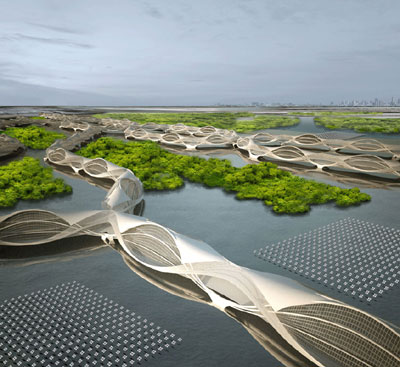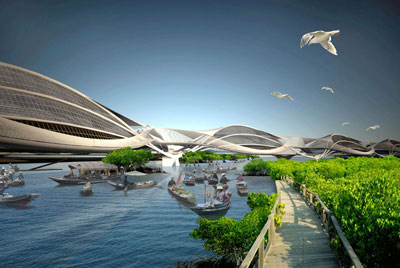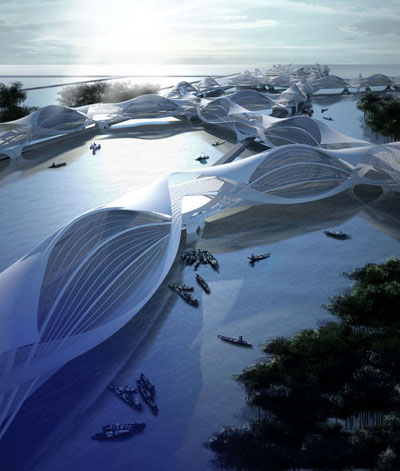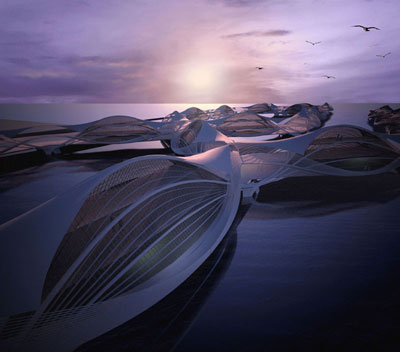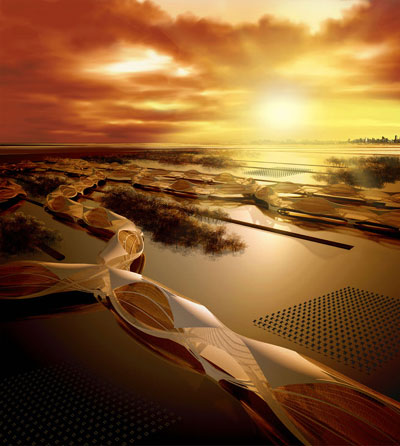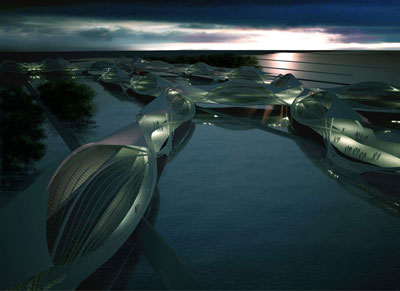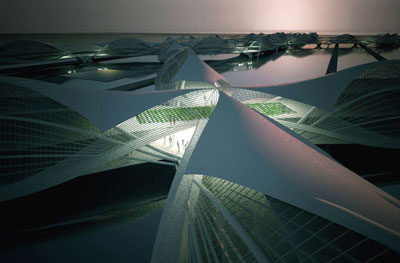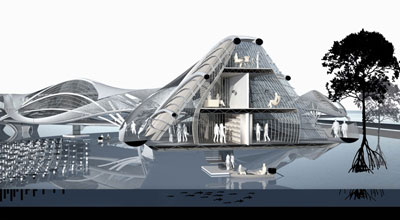|
|
 English
version English
version
El estudio de arquitectura S+PBA con origen en Bangkok
(Tailandia) exhibió su proyecto A Post-Diluvian
Future (Un Futuro Post Diluviano) en la muestra
Water: Curse or Blessing!? (Agua: ¿Maldición
o bendición?).
Como una respuesta posible al problema
del ascenso del nivel del mar y el rápido hundimiento de la ciudad
de Bangkok, los arquitectos Songsuda Adhibai,
Ponlawat Buasri y Taylor Lowe de S+PBA desarrollaron
el proyecto A Post-Diluvian Future.
El
mismo consiste en un prototipo de comunidad inspirada
en antiguas tradiciones tailandesas de "acuatectura"
adaptada a un entorno inundable y transformarlo en una
Wetropolis
contemporánea, sustentable y visualmente impactante.
A
Post-Diluvian Future
(Un Futuro Post Diluviano)
Casi 300 años después de resucitar de
entre los bancos pantanosos del Chao Phraya, pareciera
que Bangkok volverá a sus orígenes acuáticos.
Cada año su población aumenta aproximadamente
en 100,000 habitantes y la ciudad desciende 10 cm respecto
al nivel del mar.
Nos enfrentamos entonces a un dilema
post diluviano que afectará a muchas ciudades del mundo: ¿hundirse
o nadar, huir o flotar?
Mientras que al mismo tiempo que
la ciudad se hunde unos 10 cm, el nivel del mar asciende
otros 40 cm, pareciera
que el lugar más seguro para crear una nueva arquitectura
se encuentra por encima del agua.
Se plantea diseñar en este sentido, adaptando
el concepto de Metrópolis por el de Wetropolis
y el de Arquitectura por Acuatectura.
Pensando en un
futuro post diluviano se propone un prototipo de comunidad
que transforma y moderniza los principios tradicionales
de la acuatectura tailandesa en una Wetropolis contemporánea,
sustentable y visualmente impactante.
Tomando como caso
de estudio a la comunidad palafitica supra marina Koh
Pan Yii (ubicada en el mar de Andaman
al sur de Tailandia), que provee con éxito todas
las funciones típicas de una comunidad urbana,
tales como, escuelas, espacios públicos, hospitales,
servicios públicos e industria, aunque estudiando
el diseño para minimizar la huella o pisada en
el agua.
Para más información se adjunta la memoria
descriptiva completa en inglés.
English
version
The Bangkok-based Architecture
firm S+PBA has been invited to attend the exhibition Water-Curse
or Blessing!?
organized by Aedes East International Forum for Contemporary
Architecture n.p.o. as part of the Asia Pacific Weeks
2011. The event will take place at Aedes Gallery in
Berlin from the 9th to 21st September 2011.
As a possible
response to the problem of the rising sea levels and the
rapid sinking of the capital city
of Bangkok, S+PBA will present its more recent project
A Post Diluvian Future, a prototype community that takes
its inspiration from Thailand’s centuries old traditions
of floodconscious aquatecture and turn it into a contemporary
sustainable and visually stunning Wetropolis.
A Post Diluvian
Future is a project by Architects Songsuda Adhibai, Ponlawat
Buasri and Taylor Lowe from S+PBA.
A Post-Diluvian Future
by
S+PBA
While most of the world follows the standard
from dust to dust, ashes to ashes cycle, Bangkok prefers
something
wetter: from water to water. Almost 300 years after rising
from the marshy banks of the Chao Phraya, it appears
Bangkok will return to its watery origins. A recent UN
study estimates that much of the metropolitan area will
need to be abandoned by the middle of the century.
Bangkok's population is growing by approximately
100,000 residents per year, just as the city itself is
shrinking below sea level 4" per year. While most
cities in this position could simply increase urban density
by building up, this would only hasten Bangkok's
subterranean slide. It is the blinding growth of Bangkok's
built environment combined with the over-exhausted aquifers
2 m below the city surface that is causing the city's
physical depression.
We are left then with a Post-Diluvian
dilemma currently facing many world cities: do we sink
or swim, flee or
float?
With the city sinking 10 cm below a sea level that
is rising by 40 cm annually, the safest place to create
new architecture is above water. As it happens, Bangkok
is surrounded by fields of water; brackish, polluted
water remaining from an oversaturated shrimp farming
industry whose very growth precipitated its own demise.
Erstwhile
shrimp farmers, who can no longer sustain shrimp life
in their polluted plots, are currently selling
their water-fields to developers who bury the water in
housing racts, or to the government, who hopes to restore
the once thriving mangrove ecosystem.
While the government's
aspirations would yield considerable environmental benefits
to the metropolis,
they cannot compete with the prices developers would
pay for the equivalent water field. Developers, though
paying the shrimp farmers slightly more, constitute an
entirely negative environmental force by encouraging
urban spread and commuting, by stifling the possibility
for open space, and by simply burying brown-field environments
with expensive flood-susceptible, cold weather foreign
architecture.
Each party is thus engaged in a win-lose
proposition: suburbs will impair government mangroves,
water will
submerge suburbs, and shrimp farmers will lose their
livelihood. City dwellers, developers, shrimp farmers
and the environment all lose more than they gain. This
negative economy of loss occurs because Bangkok is still
laboring under a very antediluvian mindset where flooding
is considered a crisis and not a constant.
Bangkok has
always been flooded and the latest apocalyptic predictions
only suggest that flooding will return with
increased consistency. Once the city is submarine, can
we even call this phenomenon flooding? Flooding implies
a passing phase rather than a fixed environment, and
yet, at the current juncture, water is much more predictable
than land.
In order to initiate a Post-Diluvian perspective
that designs for water we must abandon the Metropolis
in favor
of the Wetropolis, and Architecture in favor of Aquatecture.
Towards a Post Diluvian Future will propose a Post-Diluvian
prototype community that transforms principles from Thailand's
centuries old traditions of flood-conscious aquatecture
into a contemporary, sustainable and visually stunning
Wetropolis.
We will examine the entirely supra-marine
stilt home community of Koh Pan Yii that hovers above
the Andaman
sea in Southern Thailand, successfully sustaining all
of the typical functions of an urban community-schools,
public spaces, hospitals, utilities, industry.
However,
unlike Koh Pan Yii, we will provide a design solution
that minimizes its foot print on the water,
thereby enabling the continued cultivation of mangrove
forests that will supply the community with carbon dioxide
mitigating flora, with a natural effluent filtration
system, with some of the only green open space in Bangkok
and with moderate local shrimp farming.
Our goal is not
to replace the Metropolis with the Wetropolis, but to
exceed it we will design a community prototype
elevated above the acres of underutilized shrimp farms
that aligns the interests of shrimp farmers, urbanites,
developers and the government by simultaneously sustaining
mangrove restoration, modest shrimp farming, and a growing
population in a sinking city that can thrive unaffected
by the impending floods.
Blessing or Curse? Flooding,
according to our community vision, will constitute a
cathartic ablution, not a cataclysmic
obliteration, of Bangkok. Water, detoxifying water, will
wash away the 20th century's misguided substitutions
of aircon for context, roads for canals, indoors for
outdoors, anesthetic environments for aesthetic environments.
Imágenes
Realice click sobre las imágenes para ampliarlas.
|







